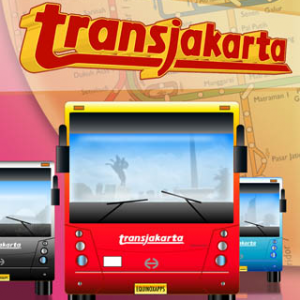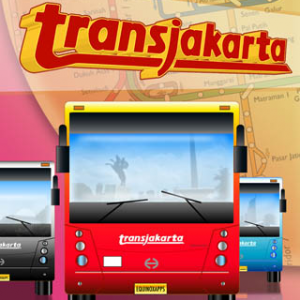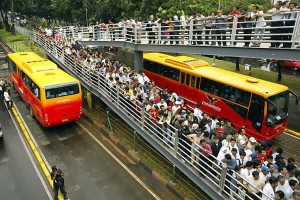 TransJakarta is a bus rapid transit (BRT) system in Jakarta, Indonesia. It was the first BRT system in Southern and Southeast Asia, and one of the first three cities to implement one in all of Asia. TransJakarta began operations on January 25, 2004. As of February 14, 2013, there were 12 corridors (or routes) in operation, with three more scheduled for construction. TransJakarta was designed to provide Jakarta citizens with a fast public transportation system, and to help reduce rush hour traffic.
TransJakarta is a bus rapid transit (BRT) system in Jakarta, Indonesia. It was the first BRT system in Southern and Southeast Asia, and one of the first three cities to implement one in all of Asia. TransJakarta began operations on January 25, 2004. As of February 14, 2013, there were 12 corridors (or routes) in operation, with three more scheduled for construction. TransJakarta was designed to provide Jakarta citizens with a fast public transportation system, and to help reduce rush hour traffic.
The system was chosen due to its lower cost in comparison with other similar mass transit systems, such as metro, subway and sky-train. Therefore, it could well be adopted by developing countries having a limited budget. The system charges a flat fare (less than 0.5US$ per trip), and its overall operational cost is subsidized by local government. To reduce waiting times, these fares are collected off-board.
Some supporting instruments are also being implemented,including:
- regulations providing fines and punishment for those who vandalize the TransJakarta facilities;
- improving quality of the TransJakarta infrastructure;
- increasing number of buses and more bus capacity through the use of articulated buses;
- provision of warning signage;
- increased number of compressed natural gas stations;
- improved facilities in the bus stations;
- improved feeder system, allowing TransJakarta to connect with railway transport for the comfort and convenience of users;
- improved image and quality of service of the system: special buses provided for women;
- reduced travel times for the system; and
- improved park and ride facilities.
In 2011, TransJakarta carried 114,783,774 passengers, or about 310,000 passengers per day, increased by 32 percent from 86,937,287 passengers the previous year. Currently, TransJakarta boasts the world’s longest BRT routes. Its 200 stations are scattered across a total system that spans 200 km, with 132 km of dedicated lanes serviced by more than 669 buses.
At the ten-year anniversary for TransJakarta in 2014, the system continues to expand its capacity to both high and low-income demographics. Coming soon, 20 new bus routes will connect some of the city’s older, more elite housing complexes with the BRT corridor, allowing Jakarta’s wealthier residents to easily access the full extent of the system’s network. Increasing convenience to persuade middle-to-upper class workers to switch to public transportation is an important part of the city’s strategy reducing both congestion and emissions.
Some information in this case study courtesy of the UNEP Publication, Reducing Emissions from Private Cars: Incentive measures for behavioural change. More information can be found at ITDP, who is working closely with TransJakarta to reach low-income residents.

